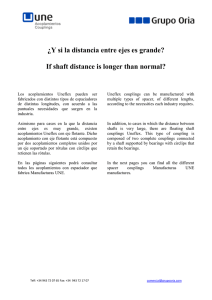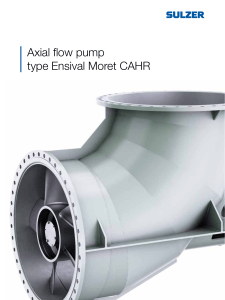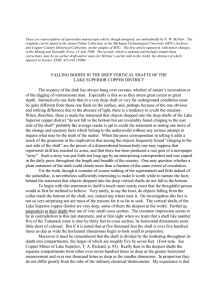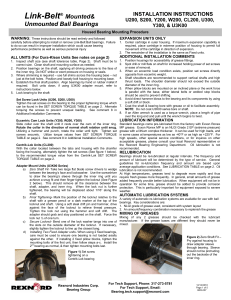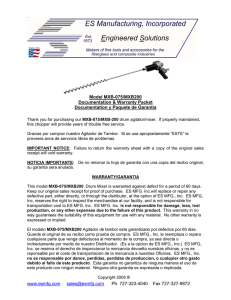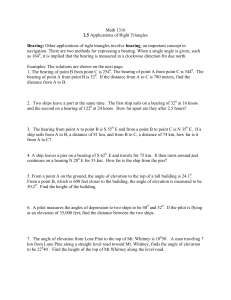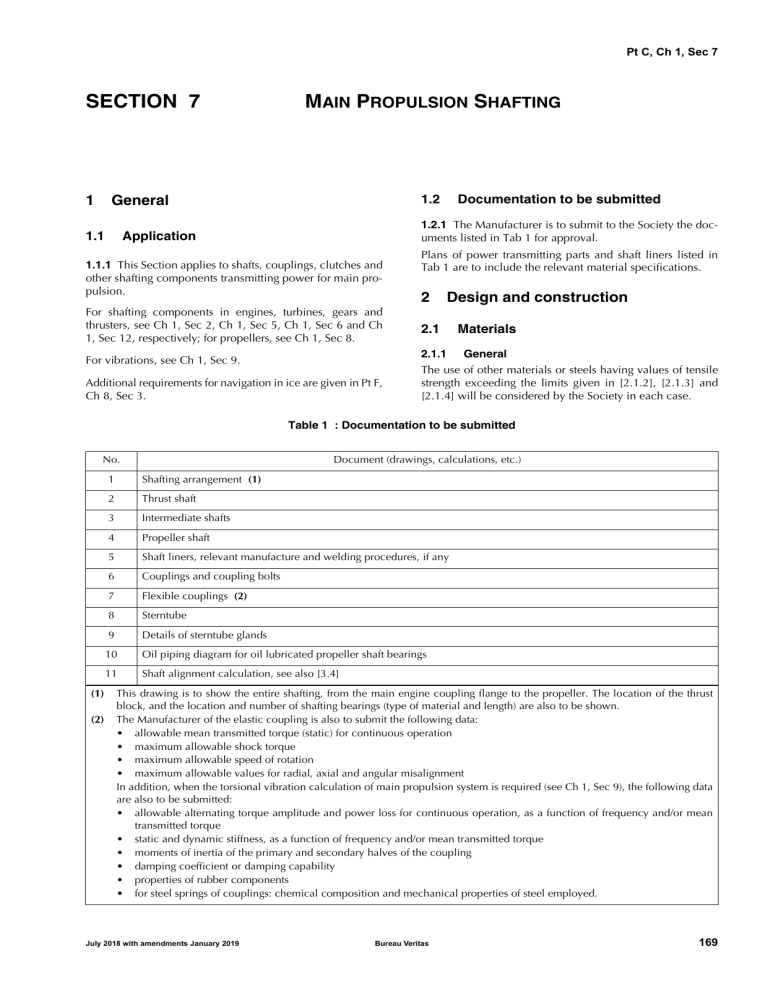
Pt C, Ch 1, Sec 7 SECTION 7 1 MAIN PROPULSION SHAFTING General 1.1 1.2 Documentation to be submitted 1.2.1 The Manufacturer is to submit to the Society the documents listed in Tab 1 for approval. Application 1.1.1 This Section applies to shafts, couplings, clutches and other shafting components transmitting power for main propulsion. For shafting components in engines, turbines, gears and thrusters, see Ch 1, Sec 2, Ch 1, Sec 5, Ch 1, Sec 6 and Ch 1, Sec 12, respectively; for propellers, see Ch 1, Sec 8. For vibrations, see Ch 1, Sec 9. Additional requirements for navigation in ice are given in Pt F, Ch 8, Sec 3. Plans of power transmitting parts and shaft liners listed in Tab 1 are to include the relevant material specifications. 2 Design and construction 2.1 Materials 2.1.1 General The use of other materials or steels having values of tensile strength exceeding the limits given in [2.1.2], [2.1.3] and [2.1.4] will be considered by the Society in each case. Table 1 : Documentation to be submitted No. (1) (2) Document (drawings, calculations, etc.) 1 Shafting arrangement (1) 2 Thrust shaft 3 Intermediate shafts 4 Propeller shaft 5 Shaft liners, relevant manufacture and welding procedures, if any 6 Couplings and coupling bolts 7 Flexible couplings (2) 8 Sterntube 9 Details of sterntube glands 10 Oil piping diagram for oil lubricated propeller shaft bearings 11 Shaft alignment calculation, see also [3.4] This drawing is to show the entire shafting, from the main engine coupling flange to the propeller. The location of the thrust block, and the location and number of shafting bearings (type of material and length) are also to be shown. The Manufacturer of the elastic coupling is also to submit the following data: • allowable mean transmitted torque (static) for continuous operation • maximum allowable shock torque • maximum allowable speed of rotation • maximum allowable values for radial, axial and angular misalignment In addition, when the torsional vibration calculation of main propulsion system is required (see Ch 1, Sec 9), the following data are also to be submitted: • allowable alternating torque amplitude and power loss for continuous operation, as a function of frequency and/or mean transmitted torque • static and dynamic stiffness, as a function of frequency and/or mean transmitted torque • moments of inertia of the primary and secondary halves of the coupling • damping coefficient or damping capability • properties of rubber components • for steel springs of couplings: chemical composition and mechanical properties of steel employed. July 2018 with amendments January 2019 Bureau Veritas 169 Pt C, Ch 1, Sec 7 2.1.2 Shaft materials Where shafts may experience vibratory stresses close permissible stresses for transient operation (see Ch 1, Sec 9), the materials are to have a specified minimum ultimate tensile strength Rm of 500 N/mm2. Otherwise materials having a specified minimum ultimate tensile strength Rm of 400 N/mm2 may be used. For use in the following formulae in this Section, Rm is limited as follows: • For carbon and carbon manganese steels, Rm is not exceed 760 N/mm2 • For alloy steels, Rm is not to exceed 800 N/mm2 • For propeller shafts, Rm is not to exceed 600 N/mm2 (for carbon, carbon manganese and alloy steels). Where materials with greater specified or actual tensile strengths than the limitations given above are used, reduced shaft dimensions are not acceptable when derived from the formulae given in this Section unless the Society verifies that the materials exhibit similar fatigue life as conventional steels (see Ch 1, App 6). 2.1.3 Couplings, flexible couplings, hydraulic couplings Non-solid forged couplings and stiff parts of elastic couplings subjected to torque are to be of forged or cast steel, or nodular cast iron. For shafts that are integral to equipment, such as for gear boxes, podded drives, electrical motors and/or generators, thrusters, turbines and which in general incorporate particular design features, additional criteria in relation to acceptable dimensions have to be taken into account. For the shafts in such equipment, the provisions of this sub-article apply only to shafts subject mainly to torsion and having traditional design features. Other shafts will be given special consideration by the Society. 2.2.2 Alternative calculation methods Alternative calculation methods may be considered by the Society. Any alternative calculation method is to include all relevant loads on the complete dynamic shafting system under all permissible operating conditions. Consideration is to be given to the dimensions and arrangements of all shaft connections. Moreover, an alternative calculation method is to take into account design criteria for continuous and transient operating loads (dimensioning for fatigue strength) and for peak operating loads (dimensioning for yield strength). The fatigue strength analysis may be carried out separately for different load assumptions 2.2.3 Shafts diameters Rotating parts of hydraulic couplings may be of grey cast iron, provided that the peripheral speed does not exceed 40m/s. The diameter of intermediate shafts, thrust shafts and propellers shafts is not to be less than that determined from the following formula: 2.1.4 Coupling bolts Coupling bolts are to be of forged, rolled or drawn steel. P 560 - ⋅ ----------------------d = F ⋅ k ⋅ ----------------------------n ⋅ ( 1 – Q 4 ) R m + 160 In general, the value of the tensile strength of the bolt material RmB is to comply with the following requirements: where: • R m ≤ RmB ≤ 1,7 R m d : Minimum required diameter in mm • R mB ≤ 1000 N/mm2. Q : Factor equal to di / do , where: 2.1.5 Shaft liners Liners are to be of metallic corrosion resistant material complying with the applicable requirements of NR216 Materials and Welding and with the approved specification, if any; in the case of liners fabricated in welded lengths, the material is to be recognised as suitable for welding. F Where shafts are protected against contact with seawater not by metal liners but by other protective coatings, the coating procedure is to be approved by the Society. 170 do : Outside diameter of the shaft, in mm. : Factor for type of propulsion installation equal to: • 100 for all other diesel installation and all propeller shafts. k : Factor for the particular shaft design features, see Tab 2 n : Speed of rotation of the shaft, in revolution per minute, corresponding to power P P : Maximum continuous power of the propulsion machinery for which the classification is requested, in kW Rm : Specified minimum tensile strength of the shaft material, in N/mm2, see [2.1.2]. Shafts - Scantling 2.2.1 General The provisions of this sub-article apply to propulsion shafts such as an intermediate and propeller shafts of traditional straight forged design and which are driven by rotating machines such as diesel engines, turbines or electric motors. : Actual diameter of the shaft bore, in mm (to be taken as 0 for solid shafts) • 95 for intermediate and thrusts shafts in turbine installations, diesel installations with hydraulic (slip type) couplings and electric propulsion installations For small shafts, the use of liners manufactured from pipes instead of castings may be considered. 2.2 di Note 1: Where di ≤ 0,4 do, Q may be taken as 0. In general, they are to be manufactured from castings. 2.1.6 Sterntubes Sterntubes are to comply with the requirements of Pt B, Ch 8, Sec 2, [6.7]. 1⁄3 Bureau Veritas July 2018 with amendments January 2019 Pt C, Ch 1, Sec 7 Table 2 : Values of factor k For thrust shafts external to engines shrink fit coupling (2) keyway, tapered connection (3) (4) keyway, cylindrical connection (3) (4) radial hole (5) longitudinal slots (6) on both sides of thrust collar (1) in way of bearing when a roller bearing is used flange mounted or keyless taper fitted propellers (7) key fitted propellers (7) between forward end of aft most bearing and forward stern tube seal propeller shafts straight sections and integral coupling flange (1) For intermediate shafts with 1,00 1,00 1,10 1,10 1,10 1,20 1,10 1,10 1,22 1,26 1,15 (1) (2) (4) (5) The fillet radius is to be in accordance with the provisions of [2.5.1]. k values refer to the plain shaft section only. Where shafts may experience vibratory stresses close to permissible stresses for continuous operation, an increase in diameter to the shrink fit diameter is to be provided, e.g. a diameter increase of 1 to 2% and a blending radius as described in [2.2.3] Note 2. At a distance of not less than 0,2 do from the end of the keyway the shaft diameter may be reduced to the diameter calculated with k = 1,0. Keyways are to be in accordance with the provisions of [2.5.5]. Diameter of the radial bore is not to exceed 0,3 do. (6) Subject to limitations as /do < 0,8 and di/do < 0,7 and e/do > 0,15, where: (3) e (7) : : slot length in mm slot width in mm The end rounding of the slot is not to be less than e/2. an edge rounding should preferably be avoided as this increases the stress concentration slightly. The k value is valid for 1, 2, 3 slots, i.e. with slots at 360 respectively 180 and respectively 120 degrees apart. Applicable to the portion of the propeller shaft between the forward edge of the aftermost shaft bearing and the forward face of the propeller hub (or shaft flange), but not less than 2,5 times the required diameter. The diameter of the propeller shaft located forward of the inboard stern tube seal may be gradually reduced to the corresponding diameter required for the intermediate shaft using the minimum specified tensile strength of the propeller shaft in the formula and recognising any limitations given in [2.1.2]. 2.3.2 Scantling The thickness of metal liners fitted on propeller shafts or on intermediate shafts inside sterntubes is to be not less than the value t, in mm, given by the following formula: Note 2: Transitions of diameters are to be designed with either a smooth taper or a blending radius equal to the change in diameter. where: d : Actual diameter of the shaft, in mm. Between the sternbushes, the above thickness t may be reduced by 25%. 2.3 2.3.1 Liners General 2.4 Metal liners or other protective coatings approved by the Society are required where propeller shafts are not made of corrosion-resistant material. Metal liners are generally to be continuous; however, discontinuous liners, i.e. liners consisting of two or more separate lengths, may be accepted by the Society on a case by case basis, provided that: • they are fitted in way of all supports • the shaft portion between liners, likely to come into contact with sea water, is protected with a coating of suitable material with characteristics, fitting method and thickness approved by the Society. July 2018 with amendments January 2019 d + 230 t = ------------------32 Stern tube bearings 2.4.1 Oil lubricated aft bearings of antifriction metal a) The length of bearings lined with white metal or other antifriction metal is to be not less than twice the rule diameter of the shaft in way of the bearing. b) The length of the bearing may be less than that given in (a) above, provided the nominal bearing pressure is not more than 0,8 N/mm2, as determined by static bearing reaction calculations taking into account shaft and propeller weight, as exerting solely on the aft bearing, divided by the projected area of the shaft. However, the minimum bearing length is to be not less than 1,5 times its actual inner diameter. Bureau Veritas 171 Pt C, Ch 1, Sec 7 2.4.2 Oil lubricated aft bearings of synthetic rubber, reinforced resin or plastics material a) For bearings of synthetic rubber, reinforced resin or plastics material which are approved by the Society for use as oil lubricated sternbush bearings, the length of the bearing is to be not less than twice the rule diameter of the shaft in way of the bearing. b) The length of the bearing may be less than that given in (a) above provided the nominal bearing pressure is not more than 0,6 N/mm2, as determined according to [2.4.1] b). However, the minimum length of the bearing is to be not less than 1,5 times its actual inner diameter. Where the material has proven satisfactory testing and operating experience, consideration may be given to an increased bearing pressure. 2.4.3 Water lubricated aft bearings of lignum vitae or antifriction metal Where the bearing comprises staves of wood (known as "lignum vitae") or is lined with antifriction metal, the length of the bearing is to be not less than 4 times the rule diameter of the shaft in way of the bearing. 2.4.4 2.4.7 For water lubricated bearings, means are to be provided to ensure efficient water circulation. In case of open loop systems, the sea water suction is normally to be from a sea chest. The water grooves on the bearings are to be of ample section such as to ensure efficient water circulation and be scarcely affected by wear-down, particularly for bearings of the plastic type. The shut-off valve or cock controlling the water supply is to be fitted direct to the stuffing box bulkhead or in way of the water inlet to the sterntube, when this is fitted forward of such bulkhead. 2.5 Grease lubricated aft bearings The fillet radius at the base of solid forged flanges is to be not less than 0,08 times the actual shaft diameter. The fillet may be formed of multi-radii in such a way that the stress concentration factor will not be greater than that for a circular fillet with radius 0,08 times the actual shaft diameter. For non-solid forged flange couplings, the above fillet radius is not to cause a stress in the fillet higher than that caused in the solid forged flange as above. Fillets are to have a smooth finish and are not to be recessed in way of nuts and bolt heads. b) Where the propeller is connected to an integral propeller shaft flange, the thickness of the flange is to be not less than 0,25 times the rule diameter of the aft part of the propeller shaft. The fillet radius at the base of the flange is to be not less than 0,125 times the actual diameter. The strength of coupling bolts of the propeller boss to the flange is to be equivalent to that of the aft part of the propeller shaft. The length of grease lubricated bearings is generally to be not less than 4 times the rule diameter of the shaft in way of the bearing. 2.4.6 c) Non-solid forged flange couplings and associated keys are to be of a strength equivalent to that of the shaft. Oil or grease lubrication system They are to be carefully fitted and shrunk on to the shafts, and the connection is to be such as to reliably resist the vibratory torque and astern pull. a) For oil lubricated bearings, provision for oil cooling is to be made. A gravity tank is to be fitted to supply lubricating oil to the sterntube; the tank is to be located above the full load waterline. Oil sealing glands are to be suitable for the various sea water temperatures which may be encountered in service. d) For couplings of intermediate and thrust shafts and for the forward coupling of the propeller shaft having all fitted coupling bolts, the coupling bolt diameter in way of the joining faces of flanges is not to be less than the value dB, in mm, given by the following formula: b) Grease lubricated bearings will be specially considered by the Society. 172 Flange couplings a) Flange couplings of intermediate and thrust shafts and the flange of the forward coupling of the propeller shaft are to have a thickness not less than 0,2 times the rule diameter of the solid intermediate shaft and not less than the coupling bolt diameter calculated for a tensile strength equal to that of the corresponding shaft. a) Where the bearing is constructed of synthetic materials which are approved by the Society for use as water lubricated sternbush bearings, such as rubber or plastics, the length of the bearing is to be not less than 4 times the rule diameter of the shaft in way of the bearing. 2.4.5 Couplings 2.5.1 Water lubricated aft bearings of synthetic materials b) For a bearing design substantiated by experimental data to the satisfaction of the Society, consideration may be given to a bearing length less than 4 times, but in no case less than 2 times, the rule diameter of the shaft in way of the bearing. Water circulation system Bureau Veritas d 3 ⋅ ( R m + 160 ) d B = 0 ,65 ⋅ ------------------------------------n B ⋅ D C ⋅ R mB 0 ,5 where: July 2018 with amendments January 2019 Pt C, Ch 1, Sec 7 d nB DC Rm RmB : Rule diameter of solid intermediate shaft, in mm, taking into account the ice strengthening requirements of Pt F, Ch 8, Sec 3, where applicable : Number of fitted coupling bolts : Pitch circle diameter of coupling bolts, in mm : Value of the minimum tensile strength of intermediate shaft material taken for calculation of d, in N/mm2 : Value of the minimum tensile strength of coupling bolt material, in N/mm2. Where, in compliance with [2.1.1], the use of a steel having RmB in excess of the limits specified in [2.1.4] is allowed for coupling bolts, the value of RmB to be introduced in the formula is not exceed the above limits. e) Flange couplings with non-fitted coupling bolts may be accepted on the basis of the calculation of bolt tightening, bolt stress due to tightening, and assembly instructions. To this end, the torque based on friction between the mating surfaces of flanges is not to be less than 2,8 times the transmitted torque, assuming a friction coefficient for steel on steel of 0,18. In addition, the bolt stress due to tightening in way of the minimum cross-section is not to exceed 0,8 times the minimum yield strength (ReH), or 0,2 proof stress (Rp 0,2), of the bolt material. Transmitted torque has the following meanings: • For main propulsion systems powered by diesel engines fitted with slip type or high elasticity couplings, by turbines or by electric motors: the mean transmitted torque corresponding to the maximum continuous power P and the relevant speed of rotation n, as defined under [2.2.3]. • For main propulsion systems powered by diesel engines fitted with couplings other than those mentioned in (a): the mean torque above increased by 20% or by the torque due to torsional vibrations, whichever is the greater. The value 2,8 above may be reduced to 2,5 in the following cases: • ships having two or more main propulsion shafts • when the transmitted torque is obtained, for the whole functioning rotational speed range, as the sum of the nominal torque and the alternate torque due to the torsional vibrations, calculated as required in Ch 1, Sec 9. The values of 0,14 and 0,18 will be taken for the friction coefficient in the case of shrinking under oil pressure and dry shrink fitting, respectively. In addition, the equivalent stress due to shrinkage determined by means of the von Mises-Hencky criterion in the points of maximum stress of the coupling is not to exceed 0,8 times the minimum yield strength (ReH), or 0,2% proof stress (Rp0,2), of the material of the part concerned. The transmitted torque is that defined under item e) of [2.5.1]. For the determination of the thrust, see Ch 1, Sec 8, [3.1.2]. 2.5.3 Other couplings Types of couplings other than those mentioned in [2.5.1] and [2.5.2] will be specially considered by the Society. 2.5.4 Flexible couplings a) The scantlings of stiff parts of flexible couplings subjected to torque are to be in compliance with the requirements of Article [2]. b) For flexible components, the limits specified by the Manufacturer relevant to static and dynamic torque, speed of rotation and dissipated power are not to be exceeded. c) Where all the engine power is transmitted through one flexible component only (ships with one propulsion engine and one shafting only), the flexible coupling is to be fitted with a torsional limit device or other suitable means to lock the coupling should the flexible component break. In stiff transmission conditions with the above locking device, a sufficiently wide speed range is to be provided, free from excessive torsional vibrations, such as to enable safe navigation and steering of the ship. As an alternative, a spare flexible element is to be provided on board. 2.5.5 Propeller shaft keys and keyways a) Keyed connexions are in general not to be used in installations with a barred speed range. b) Keyways Keyways on the propeller shaft cone are to comply with the following requirements (see Fig 1). Keyways are to have well rounded corners, with the forward end faired and preferably spooned, so as to minimize notch effects and stress concentrations. The fillet radius at the bottom of the keyway is to be not less than 1,25% of the actual propeller shaft diameter at the large end of the cone. 2.5.2 Shrunk couplings Non-integral couplings which are shrunk on the shaft by means of the oil pressure injection method or by other means may be accepted on the basis of the calculation of shrinking and induced stresses, and assembly instructions. The distance from the large end of the propeller shaft cone to the forward end of the key is to be not less than 20% of the actual propeller shaft diameter in way of the large end of the cone. To this end, the force due to friction between the mating surfaces is not to be less than 2,8 times the total force due to the transmitted torque and thrust. Key securing screws are not to be located within the first one-third of the cone length from its large end; the edges of the holes are to be carefully faired. The value 2,8 above may be reduced to 2,5 in the cases specified under item e) of [2.5.1]. Note 1: Different scantlings may be accepted, provided that at least the same reduction in stress concentration is ensured. July 2018 with amendments January 2019 Bureau Veritas 173 Pt C, Ch 1, Sec 7 Figure 1 : Details of forward end of propeller shaft keyway ≥ 0,2 d o t ≥4t r r3 do A-A ≥2t r C B r2 A B-B r r ≥ 0,0125 d o r1 < r2< r 3 r1 C-C C B A c) Keys 2.6 The sectional area of the key subject to shear stress is to be not less than the value A, in mm2, given by the following formula: 2.6.1 d3 A = 0 ,4 ⋅ -------d PM 2.6.2 Propeller shaft monitoring For the assignment of the propeller shaft monitoring system notation, see Pt F, Ch 5, Sec 2. 2.6.3 : Rule diameter, in mm, of the intermediate shaft calculated in compliance with the requirements of [2.2.3], assuming: Indicators The local indicators for main propulsion shafting to be installed on ships of 500 gross tonnage and upwards without automation notations are given in Tab 3. For monitoring of engines, turbines, gears, controllable pitch propellers and thrusters, see Ch 1, Sec 2, Ch 1, Sec 5, Ch 1, Sec 6, Ch 1, Sec 8 and Ch 1, Sec 12, respectively. Rm = 400 N/mm2 dPM General In addition to those given in this item, the requirements of Part C, Chapter 2 apply. where: d Monitoring : Actual diameter of propeller shaft at midlength of the key, in mm. The indicators listed in Tab 3 are to be fitted at a normally attended position. The edges of the key are to be rounded. Table 3 : Shafting and clutches of propulsion machinery Symbol convention H = High, HH = High high, L = Low, LL = Low low, X = function is required, Automatic control G = group alarm I = individual alarm R = remote Identification of system parameter Temperature of each shaft thrust bearing (non applicable for ball or roller bearings) Monitoring Main Engine Alarm H Stern tube bush oil gravity tank level L Clutches lubricating oil temperature H Clutches oil tank level L 174 Indication Bureau Veritas Slowdown Shutdown Auxiliary Control Stand by Start Stop X X July 2018 with amendments January 2019 Pt C, Ch 1, Sec 7 3 Arrangement and installation 3.1 3.4.2 Shaft alignment calculations a) Scope of the calculations The shaft alignment calculations are to be carried out in the following conditions: General 1) alignment conditions during the shafting installation (ship in dry dock or afloat with propeller partly immersed) 3.1.1 The installation is to be carried out according to the instructions of the component Manufacturer or approved documents, when required. 2) cold, static, afloat conditions 3) hot, static, afloat conditions 3.1.2 The installation of sterntubes and/or associated nonshrunk bearings is subject to approval of procedures and materials used. Note 1: Vertical and horizontal calculations are to carried out, as deemed relevant. 3.1.3 The joints between liner parts are not to be located in way of supports and sealing glands. b) Information to be submitted The shaft alignment calculation report should contain the following information: 4) hot, running conditions. Metal liners are to be shrunk on to the shafts by pre-heating or forced on by hydraulic pressure with adequate interference; dowels, screws or other means of securing the liners to the shafts are not acceptable. 3.2 Protection of propeller shaft against corrosion 3.2.1 The propeller shaft surface between the propeller and the sterntube, and in way of propeller nut, is to be suitably protected in order to prevent any entry of sea water, unless the shaft is made of austenitic stainless steel. 3.3 3.3.1 Shaft alignment for ships granted with a notation ESA Application Ships having the additional service feature or additional class notation ESA, as described respectively in Pt A, Ch 1, Sec 2, [4.1.5] and in Pt A, Ch 1, Sec 2, [6.14.31], are to comply with the requirements of Rule Note NR592 Elastic Shaft Alignment. 3.4 3.4.1 Shaft alignment for ships not granted with a notation ESA General For ships to which the notation ESA is not assigned, shaft alignment calculations and shaft alignment procedures are to be submitted for review in the following cases: • propulsion plants with a shaft diameter of 300 mm or greater in way of the aftermost bearing, whether or not they comprise a gearbox • geared propulsion plants with power take-in (PTI) or power take-off (PTO), where the shaft diameter in way of the aftermost bearing is 150 mm or greater. July 2018 with amendments January 2019 Bureau Veritas 1) Description of the shaftline model: • length, diameters and density of material for each shaft • definition of the reference line • longitudinal, vertical and horizontal position of the bearing with respect to the reference line • bearings characteristics: material, length, clearance. 2) Input parameters • hydrodynamic propeller loads (horizontal and vertical forces and moments) • weight and buoyancy effect of the propeller, depending on the propeller immersion corresponding to the different loading cases of the ship • engine power and rotational speed of the propeller (for calculations in running conditions) • machining data of aft bush slope boring • for slow speed engines, equivalent model of the crankshaft, with indication of the input loads • for geared installation, gear tooth forces and moments • thermal expansion of the gearbox or of the main engine between cold and hot conditions • jack-up location. 3) Limits • limits specified by engine or gearbox manufacturer (such as allowable bearing loads, allowable moments and forces at the shaft couplings) • allowable loads specified by bearing manufacturer. 4) Results • bearings influence coefficients table • expected bearing reactions, for the different calculation conditions • expected shaft deflections, shear forces and bending moments alongside the shaftline, for the different calculation conditions • gap and sag values (depending on the alignment method) • jack-up correction factors. 175 Pt C, Ch 1, Sec 7 c) Acceptability criteria for the calculations 3.4.4 Verification of the alignment procedure The purpose of the verification procedure is to ensure that the alignment measurements comply with the calculated values. The shaft alignment verification procedure is described in Ch 1, Sec 15, [3.11.1]. The results of the shaft alignment calculations are to comply with the following acceptability criteria: • Relative slope between propeller shaft and aftermost boring axis is not to exceed 0,3 mm/m The shaft alignment verification is to be carried out by the shipyard in presence of the Surveyor and submitted to the Society. • all bearings are to remain loaded • loads on intermediate shaft bearings are not to exceed 80% of the maximum permissible load specified by the manufacturer The criteria for acceptability of the alignment conditions include the following: • stern tube bearing loads are not to exceed the limits started in [2.4]. 3.4.3 • the position of the two aftermost bearings should not differ from the specified offsets by more than ± 0,1 mm. • Gap and sag values should not differ from the calculated values by more than ± 0,1 mm. Shaft alignment procedure The shaft alignment procedure is to be submitted for review and is to be consistent with the shaft alignment calculations. • Bearing loads should not differ from the calculated values by more than ± 20%. The shaft alignment procedure should include at least the following: 4 • Ship conditions in which the alignment is to be carried out (drafts, propeller immersion, engine room temperature) 4.1 Material tests, workshop inspection and testing, certification • Method used for establishing the reference line (using laser or optical instruments or piano wire) Material and non-destructive tests, workshop inspections and testing - bearing slope boring 4.1.1 Material tests Shafting components are to be tested by the Manufacturer in accordance with Tab 4 and in compliance with the requirements of NR216 Materials and Welding. - setting of the bearing offset and installation of the temporary shaft support (where relevant) in accordance with the results of the shaft alignment calculation Magnetic particle or liquid penetrant tests are required for the parts listed in Tab 4 and are to be effected in positions agreed upon by the Surveyor, where Manufacturer’s experience shows defects are most likely to occur. - flange coupling parameter setting (gap and sag) - bearing load test (jack-up test). Ultrasonic testing requires the Manufacturer’s signed certificate. • Description of the different steps of the shafting installation: Table 4 : Material and non-destructive tests Shafting component Material tests (Mechanical properties and chemical composition) Non-destructive tests Magnetic particle or liquid penetrant Ultrasonic 1) Coupling (separate from shafts) all if diameter ≥ 100 mm (1) if diameter ≥ 200 mm (1) 2) Propeller shafts all if diameter ≥ 100 mm (1) if diameter ≥ 200 mm (1) 3) Intermediate shafts all if diameter ≥ 100 mm (1) if diameter ≥ 200 mm (1) 4) Thrust shafts all if diameter ≥ 100 mm (1) if diameter ≥ 200 mm (1) 5) Cardan shafts (flanges, crosses, shafts, yokes) all if diameter ≥ 100 mm (1) if diameter ≥ 200 mm (1) 6) Sterntubes all − − 7) Sterntube bushes and other shaft bearings all − − 8) Propeller shaft liners all − − 9) Coupling bolts or studs all − − 10) Flexible couplings (metallic parts only) all − − 11) Thrust sliding-blocks (frame only) all − − (1) 176 150 mm in case of a rolled bar used in place of a forging Bureau Veritas July 2018 with amendments January 2019 Pt C, Ch 1, Sec 7 4.1.2 4.2 Hydrostatic tests Parts of hydraulic couplings, clutches of hydraulic reverse gears and control units, hubs and hydraulic cylinders of controllable pitch propellers, including piping systems and associated fittings, are to be hydrostatically tested to1,5 times the maximum working pressure. Sterntubes, when machine-finished, and propeller shaft liners, when machine-finished on the inside and with an overthickness not exceeding 3 mm on the outside, are to be hydrostatically tested to 0,2 N/mm2. July 2018 with amendments January 2019 Certification 4.2.1 Testing certification Society’s certificates (C) (see NR216 Materials and Welding, Ch 1, Sec 1, [4.2.1]) are required for material tests of components in items 1 to 5 of Tab 4. Works’ certificates (W) (see NR216 Materials and Welding, Ch 1, Sec 1, [4.2.3]) are required for hydrostatic tests of components indicated in [4.1.2] and for material and nondestructive tests of components in items of Tab 4 other than those for which Society’s certificates (C) are required. Bureau Veritas 177

